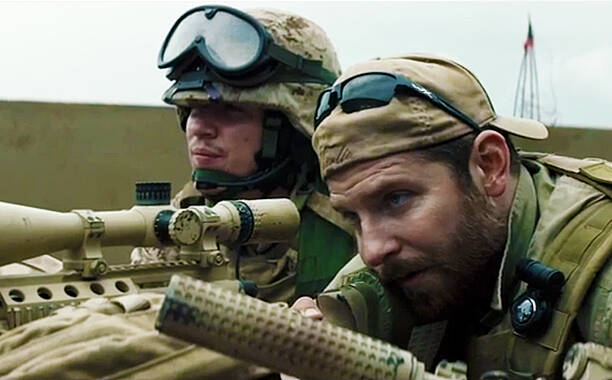For a lot of reasons I had put off seeing “American Sniper.” The thought of two hours watching a guy with a beard, rifle and telescopic sight on a rooftop gain honor and fame by bumping off a minimum of 160 men, women and children would neither entertain me nor make me love my country more. But when it became controversial and was nominated for an Oscar I knew I had to see it if I wanted to talk about it.
Watching it was not quite what I had expected, and I left the theater feeling that somehow I had seen the same picture for the third time. The characters were different, but for “Unbroken,” “Selma” and “Sniper,” the feel was the same. They shared idealistic heroes, long-suffering wives, two deaths by assassination, real or imitation heroism, two wars and processions, and a climactic gush of pride in being an America. It’s as if Hollywood has conspired to make us feel better about our issues of race, death and war.
I was struck by “Sniper’s” one-note unity in tone. Young patriotic gun-lover SEAL Chris Kyle (Bradley Cooper) marries Taya, a beautiful girl he meets in a service-men’s hang out, serves four tours in Iraq, interrupted by trips home to check in with his wife and new-born son and daughter. His wife pleads with him to leave the service but his sense of “duty” keeps him going, in spite of symptoms that stress in breaking him.Two scenes show us the film’s heart: the protagonist, Kyle and girl friend watch the World Trade Center burn,and the audience feels that Chris has to do something about this. At their outdoor Texas wedding word arrives that the U.S. had declared war on Iraq, and all wave their champagne glasses and cheer. The battle scenes reminded me of the one-note B Westerns I grew up on: bad men control a frontier town (Fallujah) and good men do their best to kill them. Everyone whom Kyle kills deserves to die, including the little boys and women because they are carrying bombs. The last battle, a determination to wipe out a nest of Iraqi fighters to revenge the death of a comrade ends in a swirl of smoke and dust in which the Americans must be rescued by their helicopters.
Defenders of the film, including Michelle Obama, praise it for calling our attention to the psychological sufferings of the troops. Back home Kyle is falling apart, he blows up at a dog wrestling a child at a lawn party. He visits a psychiatrist who introduces him to a therapy group of wounded veterans, and Bingo!, he’s cured. If this was director Clint Eastwood’s main purpose, he should have it more than a few minutes. Kyle is now smiling at home and teaching his young son to shoot a rifle. One afternoon he goes to see a fellow veteran he is “helping,” and a note on the screen tells us Kyle was killed. The epilogue is a funeral procession rivaling the march to Selma. Tears came to my eyes.
For me the omission of one fundamental truth undermines the integrity of the film’s patriotism. Iraq had nothing to do with the destruction of the World Trade Center. We were not fighting Osama Ben Laden in Baghdad or Fallujah.We were killing the citizens of a country we had invaded under false pretenses. All those dead Americans and Iraqis had no reason to die or suffer lost legs, arms or minds.
The most damaging criticism of the film comes from seminary-trained 15-year foreign correspondent, author of War Is A Force That Gives Us Meaning, and bloggerChris Hedges, whom I know and who has helped me teach my classes. The film Chris Kyle is a sanitized version of the author of the memoir on which the film is based. Hedges opens his attack: “‘American Sniper’ lionizes the most despicable aspects of U. S. society—the gun culture, the blind adoration of the military, the belief that we have an innate right as a ‘Christian’ nation to exterminate the ‘lesser breeds’ of the earth, a grotesque hypermasculinity that banishes compassion and pity, a denial of inconvenient facts and historical truth, and a belittling of critical thinking and artistic expression.” As I said to myself coming out of the theater, Americans somehow “yearn for the supposed moral renewal” that movies like this are supposed to generate.
Hedges recalls an opening scene where Kyle’s father tells the children there are three kinds of people in the world, “sheep, wolves and sheep dogs.” Those with the blessed gift of aggression must confront the wolves. He does not want sheep in the family. The target audience of a film like this, says Hedges, “prefer drinking beer and watching football to reading a book.” The SEALs whom the movie glorifies are drained of individuality. In an early bar scene when Kyle meets Taya, a shirtless SEAL offers his bare back as a target into which his pals throw darts. In Fallujah his platoon members paint a white skull of the Punisher on their vehicles and weapons and encircle it with the motto: “Despite what your momma told you...violence does solve problems.” In the book, says Hedges, Kyle loves being a Christian, relishes killing and war, hates all Iraqis and is “intoxicated by violence.”
Googling Kyle’s death I learned that he was shot by a deranged fellow vet at a rifle range. The culprit will be tried in September. Following up on that story led to a report that Kyle told a reporter, as well as friends, that in 2009 he killed two armed men at a gas station who were trying to steal his truck. Police did not follow up because he was a “war hero.” The cloud of sadness descends over all this. In the long run perhaps Clint Eastwood and his writers should have told the whole story or not told it at all.








